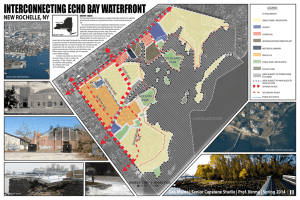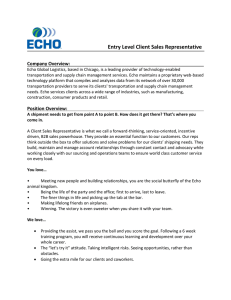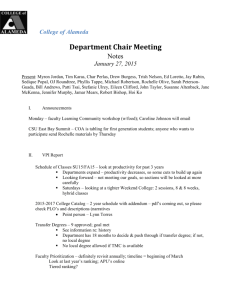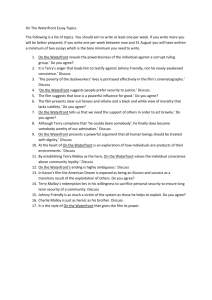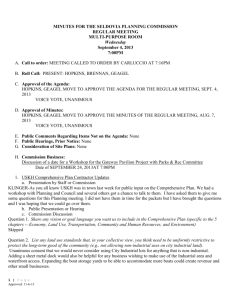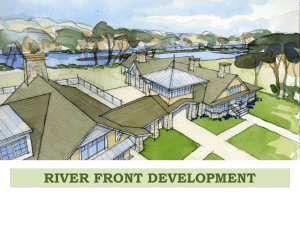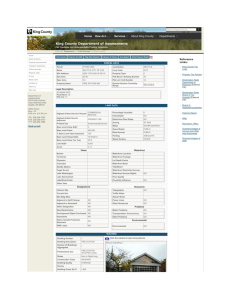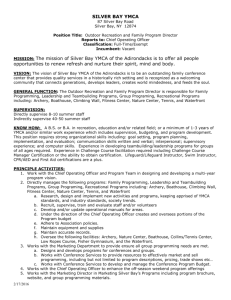n e W r o c h e... e c h o b ay WAterfront recoVery site AnALysis
advertisement
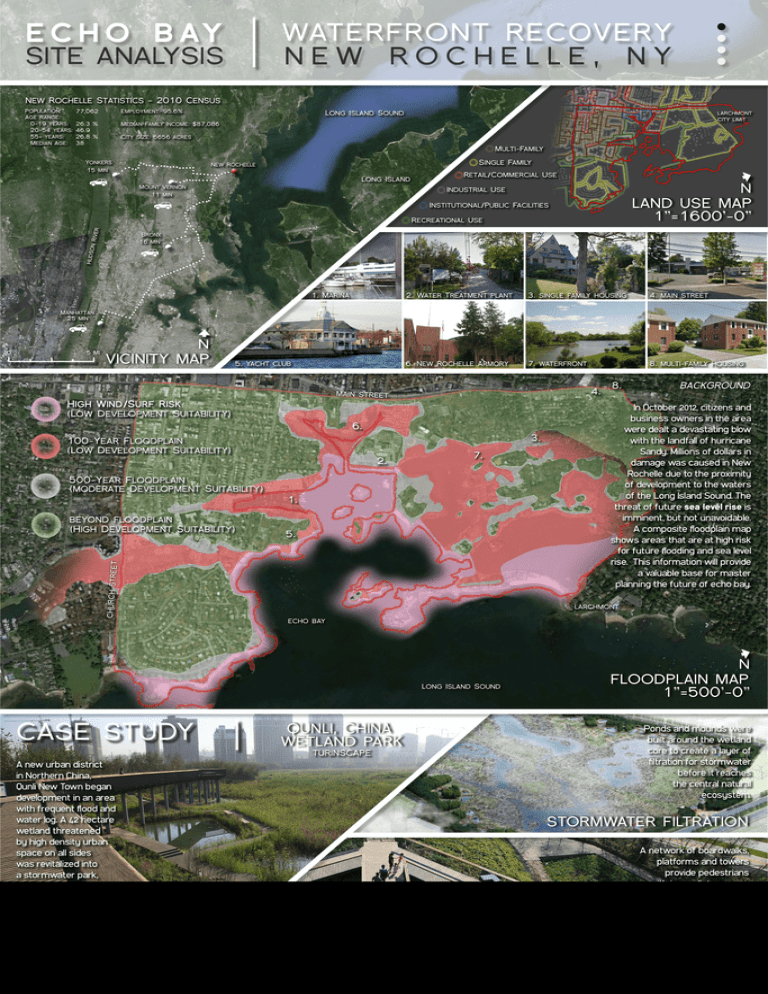
e c h o b ay site analysis Waterfront recovery n e w r o c h e ll e , n y New Rochelle Statistics - 2010 Census Population: Age Range: 0-19 years: 20-54 years: 55+ years: Median Age: 77,062 Employment: 95.6% 26.3 % 46.9 26.8 % 38 Median Family Income: $87,086 Long Island Sound larchmont city limit City Size: 6656 acres Multi-Family Yonkers 15 min Single Family New Rochelle Long Island Mount Vernon 11 min Retail/Commercial Use N Land Use Map 1”=1600’-0” Industrial Use Institutional/Public Facilities Hudso n Rive r Recreational Use Bronx 16 min 1. Marina 2. Water Treatment plant 3. single family housing 4. main street 6. New Rochelle Armory 7. waterfront 8. multi-family housing Manhattan 25 min 5 mi 5. Yacht club 4. main street High Wind/Surf Risk (Low Development Suitability) 6. 3. 100-Year Floodplain (Low Development Suitability) 2. 7. 500-Year Floodplain (moderate Development Suitability) 1. beyond floodplain (High Development Suitability) church stree t 0 N vicinity map 5. Eco urban core In October 2012, citizens and business owners in the area were dealt a devastating blow with the landfall of hurricane Sandy. Millions of dollars in damage was caused in New Rochelle due to the proximity of development to the waters of the Long Island Sound. The threat of future sea level rise is imminent, but not unavoidable. A composite floodplain map shows areas that are at high risk for future flooding and sea level rise. This information will provide a valuable base for master planning the future of echo bay. echo bay qunli, China wetland park turinscape A new urban district in Northern China, Qunli New Town began development in an area with frequent flood and water log. A 42 hectare wetland threatened by high density urban space on all sides was revitalized into a stormwater park, providing habitats and ecosystems for wildlife and Qunli residents alike. background larchmont Long Island Sound case study 8. N FloodPlain Map 1”=500’-0” Ponds and mounds were built around the wetland core to create a layer of filtration for stormwater before it reaches the central natural ecosystem. stormwater filtration A network of boardwalks, platforms and towers provide pedestrians with immediate access to the natural systems at the center of their community. Wetland access Joseph Werner - LAND 4900 - Spring 2014 - Professor Verma e c h o b ay master Plan Waterfront recovery n e w r o c h e ll e , n y main street New Rochelle Armory museum bo echo bay convention center pedestrian Bridge rd eva ul church street rd bo eva ul boardwalk Nexus (Site Plan) civic Center Educational water treatment facility marina Echo Bay Aquarium Wetlands boardwalks Echo Bay New Causeway N master Plan 1”=400’-0” echo bay Park Long island Sound new piers concept causeway In the new, resilient master plan, these areas were avoided in terms of future development wherever possible. A safe-to-fail approach was taken in areas threatened by flooding with the use of boardwalks, piers and other pedestrian areas. Accessible wetlands have retaken much of the waterfront, and densified development further inland is permeated by green corridors that bring people to the water’s edge. Development on the waterfront has been separated into pockets in order to protect and enhance the surrounding wetlands. These pockets create several different communities connected by bridges, allowing for circulation between different land uses, such as residential, commercial, business and institutional and protected wetlands. A number of different features are located across the waterfront, including the Echo Bay Aquarium, New Rochelle Armory Museum, Water Treatment Facility, the Echo Bay Convention and Civic Centers and Echo Bay Park. pedestrian bridges wetland observation Joseph Werner - LAND 4900 - Spring 2014 - Professor Verma e c h o b ay s i t e p la n Waterfront recovery n e w r o c h e ll e , n y a inundation net void floating platform kayak launch Concrete stairs lead down and away from the sidewalk of an urban street, providing a significant change in elevation that will allow for sea level rise to occur without major harm to any commercial or residential development. These variable periods of inundation limit access to lower boardwalks based on the tides in Echo Bay. This site plan shows a tiered public space directly over the grassy waters of Echo Bay. A number of different level changes allow pedestrians to experience space from a distance before arriving. A combination of curves and straight lines provide a juxtaposition between natural and built forms. Avenues of small trees provide shade in some areas, while others remain bathed in sunlight. k high Boardwal st ai rs N site Plan 1”=30’-0” es ac c nt ro rf w wa te lo Beyond the densified mixed-use development of New Rochelle’s coastline, a network of boardwalks creates ample opportunities for pedestrians to experience the waterfront and nature first-hand. A series of public spaces creates a diverse range of experiences, views and opportunities for immersion in the wetland environment. These escapes from the nearby urban atmosphere provide the public with waterfront access that can easily be found by following the street grid to its edge on any side. s immersion k dwal ar bo a Locator Map waterfront access 1”=30’-0” boardwalk section aA Joseph Werner - LAND 4900 - Spring 2014 - Professor Verma e c h o b ay detail plan Waterfront recovery n e w r o c h e ll e , n y b relaxation net rdwalk a o b d e r ie t stairs stairs ch kayak laun N detail Plan 1”=10’-0” raised seating retreat Raised seating areas provide space for lounging, dining and viewing people and spaces below. Some voids in the boardwalk are lined with netting for suspended lounging above the water. All planters are bound with seat walls for convenient pedestrian respite. Steps recede into the water around a kayak ramp for easy access. The result of these spaces combined is the transition between a densified community and a natural wetland that opens into the Long Island Sound. With a network of safe-to-fail boardwalks in place of waterfront development, New Rochelle becomes a resilient community that will be protected from future sea level rise and storm surges for generations to come. raised seating B tiered boardwalk 1”=10’-0” boardwalk section BB Joseph Werner - LAND 4900 - Spring 2014 - Professor Verma
